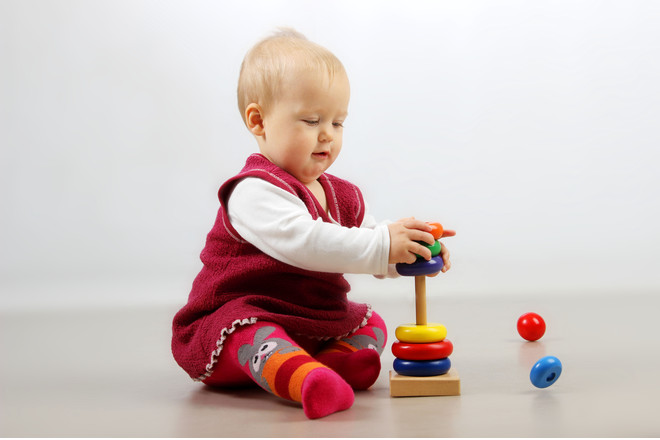
The Importance Of Playtime
by Sarah Keith
Playful interactions between a parent and an infant provide all-important bonding opportunities and encourage a baby’s natural development.
What you say
Your baby is noticing and reacting to sounds, turning toward your voice, and making a variety of sounds of her own. Play that helps with talking and listening can be easy to incorporate into your routines.
Talking to your baby and narrating activities can be soothing, and it encourages language development. Your baby is learning from the tone in your voice and your inflection. Respond to your baby’s sounds as though you are having a conversation.
Singing, rhyming, and responding to the noises your baby makes are also ways to interact playfully. Making a variety of noises, like whispering, giggling and humming can be a fun way to stimulate your infant. Let her put her hands on your lips while you make sounds so she can feel the vibrations.
Your baby will hear a variety of sounds as you venture out together. The park, the zoo, the grocery store—all will offer the chance to hear different sounds. Talk about what you are hearing.
What you see
Play that engages baby’s hands and eyes can also be fun. Your new baby is able to gaze into your eyes as you feed him. Explore baby’s growing ability to see faces, colors and movement.
“Ah-Boo” is an earlier version of peek-a-boo: place your baby on your lap in front of you. Smile and say “aaahh-boo” (not too loudly) as you lean toward baby and gently touch your forehead to his. Repeat as long as it seems enjoyable to baby. Gently rubbing noses and kissing his cheeks, fingers and toes are also good ways to engage.
Tracking is another way to engage your baby. Place her on the floor and hold a brightly colored object about 12 inches over her head. Jiggle it to get her attention. Once she is focused on the object, move it from side to side slowly, allowing her to follow it with her eyes. It can also be fun for baby to watch fish swim in a fish tank, or birds fly.
Make faces! Smile, wink, wiggle your eyebrows and be silly for your baby. Place a picture of a face with well-defined eyes and eyebrows on the right side of the crib. Most babies turn their head to the right side about 85 percent of the time. When your baby is awake, she may enjoy staring at the face.
Bright colors and stark contrasts are most interesting to your baby. Try creating cards with bright, bold patterns, about eight inches square. Place them on the side of his crib or hold them up for him.
What you do
Gently touching your baby helps her to become aware of her body. Move her arms and legs; touch her hands, fingers, feet and toes. Play roly-poly by gently rolling baby from tummy to back.
Once your baby has control of her head, lie on the floor and place her on your chest. Let her reach for your nose, grab your hair, and look into your face. Hold her in the air over your head, look into her face and talk to her.
Hold a toy that makes an interesting noise over your baby’s head. Jiggle it so he can hear the noise, and he will begin batting at it with his hands and kicking it.
Most of all, remember that you are your baby’s favorite toy. Tuning in to your baby and being playful together will form the foundation for a strong, healthy relationship that you will build on for years to come.

